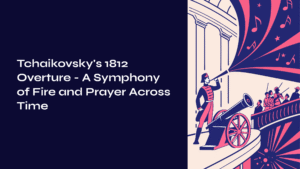Table of Contents
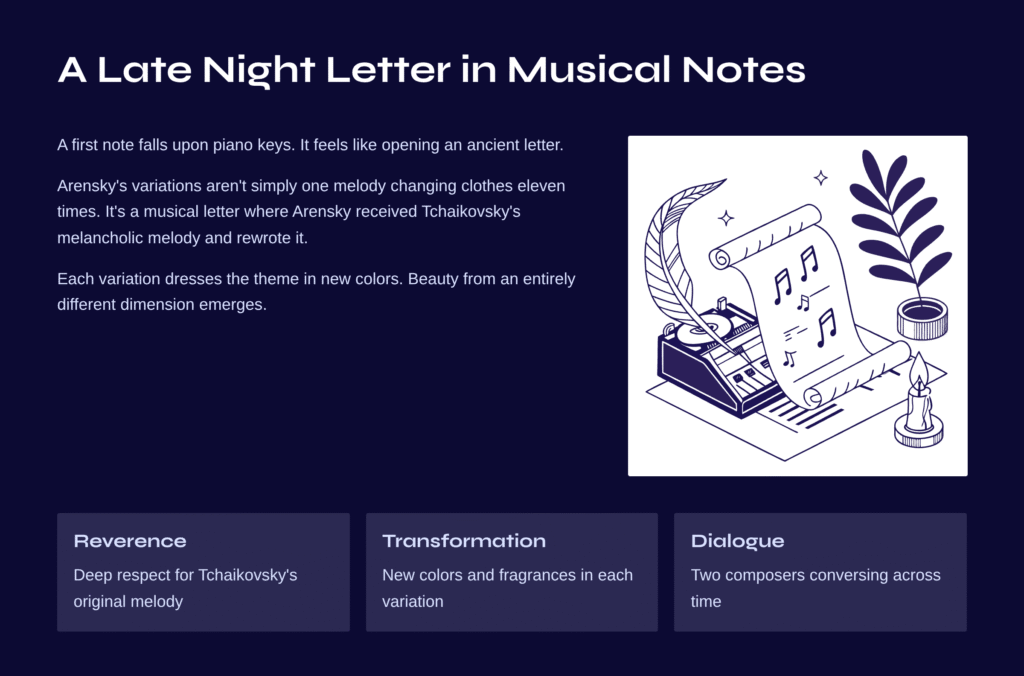
A Late Night Letter in Musical Notes
In the depths of night, there exists a first note falling upon piano keys. That sound feels like opening an ancient letter. A moment when someone’s love confession written in the distant past is reborn as a new story through another’s hands. Every time I listen to Arensky’s “Variations on a Theme by Tchaikovsky” Op.35a, I experience this sensation.
This piece is not simply a story of one melody changing clothes eleven times. It is a musical letter where Arensky received Tchaikovsky’s melancholic melody and rewrote it in his own language. While respecting the profound emotions of the original, each variation dresses the theme in new colors and fragrances, offering beauty from an entirely different dimension.
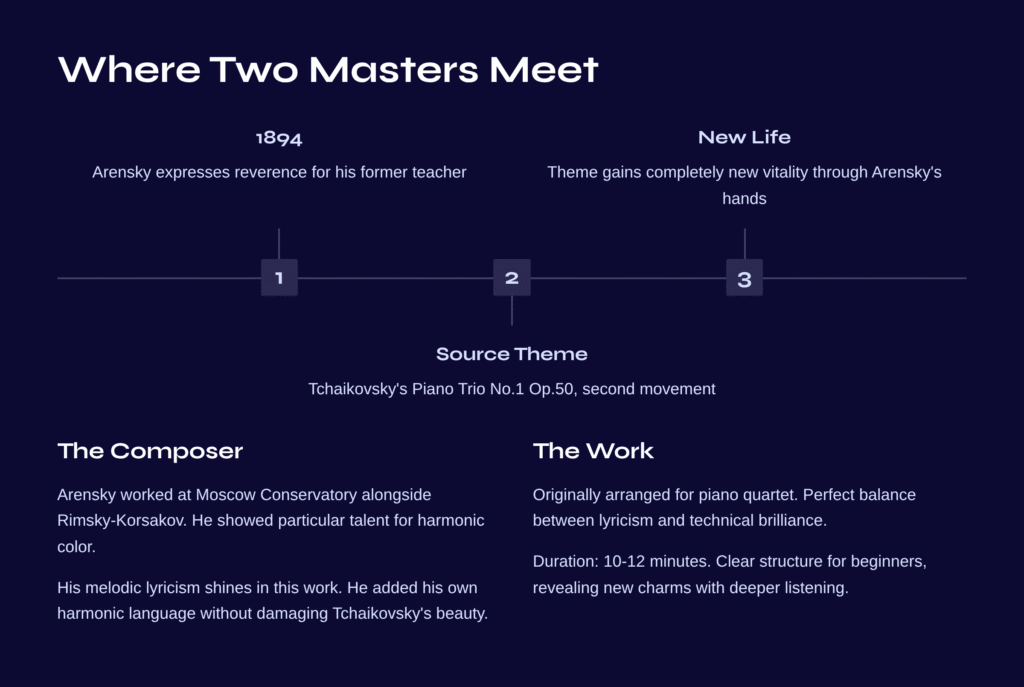
Where Two Masters Meet
In 1894, Anton Arensky expressed his deep reverence for Tchaikovsky, his former teacher, through music. The “Andante cantabile” theme taken from the second movement of Tchaikovsky’s Piano Trio No.1 Op.50 was already famous for its poignant and lyrical melody, but through Arensky’s hands, it gained completely new vitality.
Arensky was a Russian Romantic composer who worked at the Moscow Conservatory alongside Rimsky-Korsakov. He showed particular talent for harmonic color and melodic lyricism, characteristics that are most clearly displayed in this set of variations. Without damaging the primordial beauty of Tchaikovsky’s melody, he added his own harmonic language and rhythmic sensibility to create eleven different worlds.
Originally arranged for piano quartet, this work achieves perfect balance between lyricism and technical brilliance within the appropriate length of about 10-12 minutes. While maintaining a clear structure that even classical beginners can easily follow, it reveals new charms the more deeply one listens.

Eleven Windows Viewing One Landscape
Theme – The First Greeting
Everything begins with a quiet greeting. The theme melody flowing from the middle-low register feels like the first words exchanged between old friends. This melody in G minor, filled with melancholy, is not complex, but deep layers of emotion hide within its simplicity. It possesses the power to calm the listener’s heart, perfectly serving as the departure point for all the variations that follow.
Variations 1-3: Waves of Lyricism
In the first variation, the melody repeats in octaves, resonating like an echo. While maintaining the melancholy of the original melody, it creates deeper spatial sense through the expansion of register. The second variation adds delicate trill ornaments in the right hand, offering trembles like raindrops falling on water.
By the third variation, the left-hand accompaniment becomes slightly more active. However, the lyrical atmosphere is still maintained, and the added rhythmic sense makes the music feel more alive and breathing. These three variations show subtle differences like viewing the same landscape at morning, noon, and evening hours.
Variations 4-6: Explosion of Virtuosity
From the fourth variation onward, a completely different world unfolds. Octave repetitions and arpeggios in both hands appear magnificently, and the originally quiet melody suddenly becomes a grand waterfall cascading down. However, this brilliance is never for the sake of showing off technique. It expresses the emotional depth of the original in a different way.
In the fifth variation, even more brilliant accompaniment is layered above the octave melody. It feels like all instruments of an orchestra singing together in richness. The sixth variation is the climax of this series, with rapid scales ascending and descending the keyboard, testing the performer’s skill. Yet even here, the original melody line is clearly audible, ensuring we don’t miss the true musical message hidden behind the virtuosity.
Variations 7-9: Time to Catch One’s Breath
After passing the peak of technical brilliance, the music becomes calm again. The seventh variation begins with gentle arpeggios, giving a feeling like the stillness after a storm has passed. Here, the listener takes a moment to breathe and reflect on the musical journey that has passed.
In the eighth variation, the right-hand chords are particularly emphasized. This section, where harmonic color stands out, offers beauty like light entering through stained glass. In the ninth variation, octaves appear again, but create a calm and deep resonance different from the previous brilliance.
Variations 10-11: The Magic of Dramatic Transformation
The tenth variation is the most dramatic moment of this work. A modulation from G minor to major occurs, and the atmosphere that had been melancholy and lyrical suddenly becomes bright and hopeful. At this moment, the listener experiences shocking emotion like suddenly encountering sunlight after passing through a long tunnel.
The final eleventh variation incorporates contrapuntal elements, making the musical structure more complex. This section, where multiple voices dialogue and interweave with each other, feels like multiple narrators simultaneously telling the same story from different perspectives. Dramatic tension reaches its peak, serving as a perfect bridge leading to the coda.
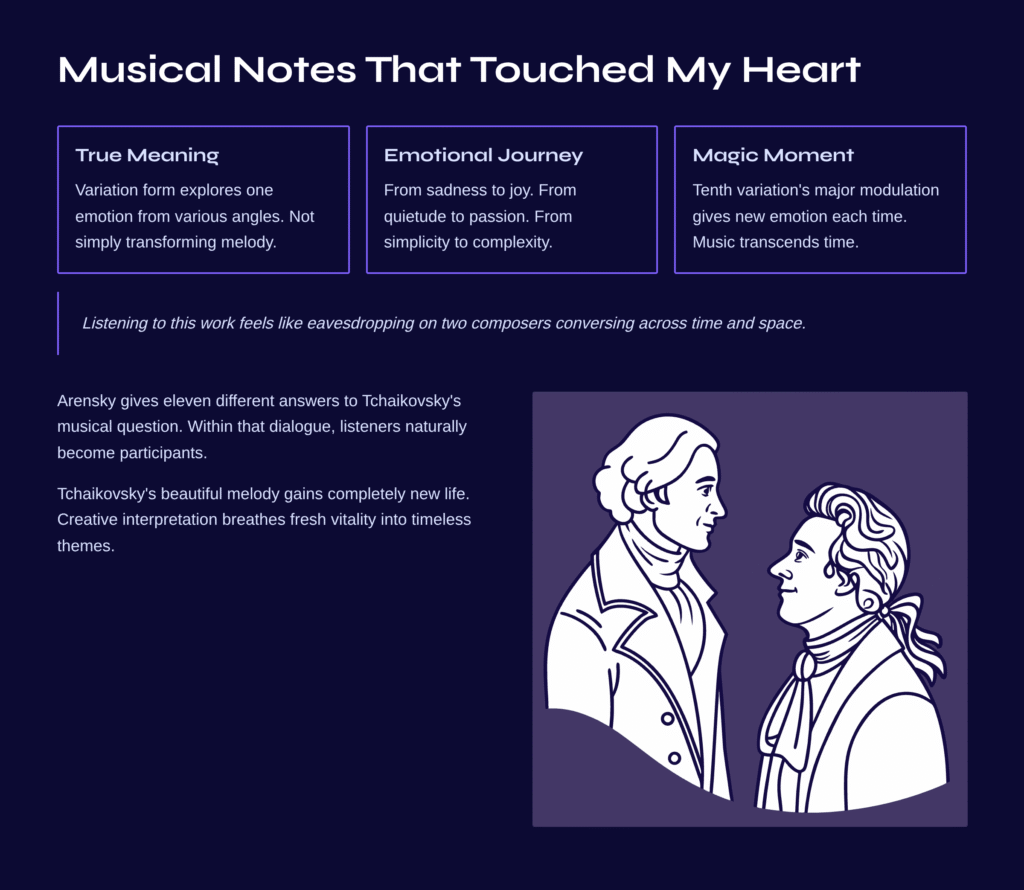
Musical Notes That Touched My Heart
When I first heard this piece, I realized the true meaning of the variation form. It’s not simply transforming a melody, but a process of exploring one emotion from various angles. The melancholy of Tchaikovsky’s original continuously changes through Arensky’s hands—from sadness to joy, from quietude to passion, from simplicity to complexity.
Particularly, the moment of modulation to major in the tenth variation gives new emotion each time I hear it. In that moment, I realize that music is not simply a combination of sounds, but an emotional language that transcends time. It’s also the moment when Tchaikovsky’s beautiful melody gains completely new life through Arensky’s creative interpretation.
Listening to this work feels like eavesdropping on two composers conversing across time and space. It seems as if Arensky is giving eleven different answers to the musical question posed by Tchaikovsky. And within that dialogue, I, as a listener, naturally become a participant.
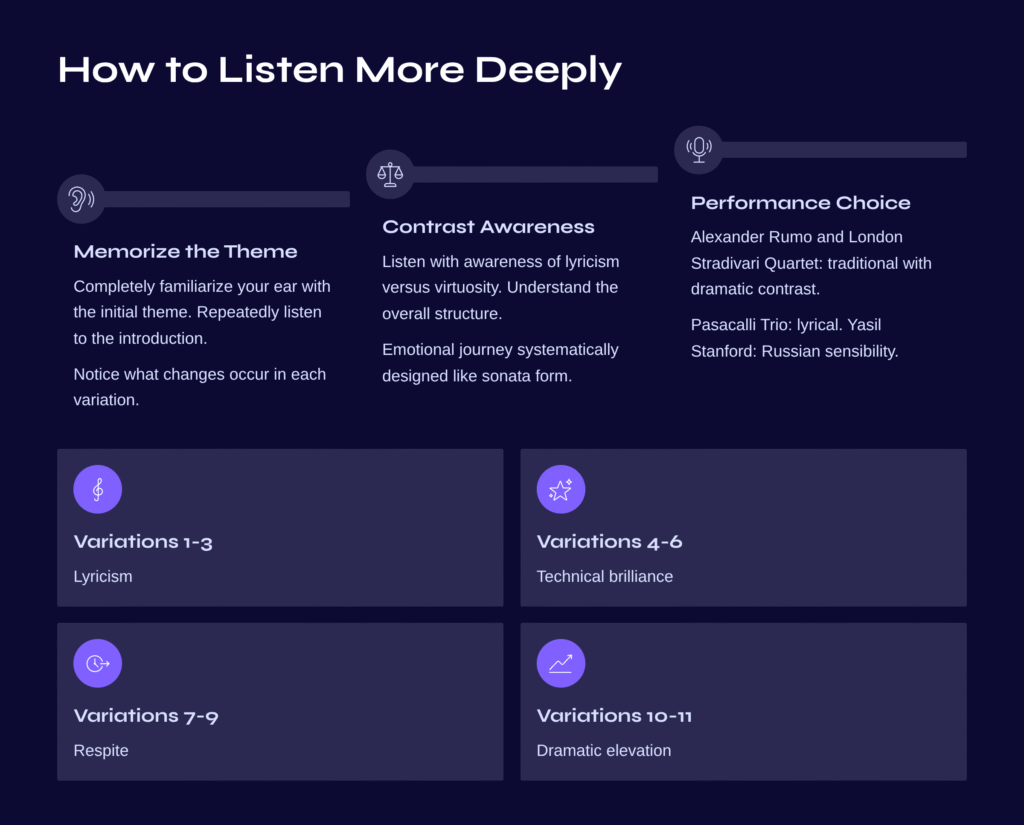
How to Listen More Deeply
To properly appreciate this work, it’s good to pay attention to several points. First, it’s important to completely familiarize your ear with the initial theme. By repeatedly listening to the introduction and memorizing that melody line, you can more clearly notice what changes occur in each variation.
Second, I recommend listening with awareness of the contrast between lyricism and virtuosity. Understanding the overall structure—the lyricism of variations 1-3, the technical brilliance of 4-6, the respite of 7-9, and the dramatic elevation of 10-11—will help you better understand the composer’s intentions. This is an emotional journey systematically designed like sonata form.
Finally, the choice of performance version is also important. The performance by Alexander Rumo and the London Stradivari Quartet is traditional yet has clear dramatic contrast, suitable for beginners. If you want a more lyrical interpretation, I recommend the Pasacalli Trio version; for Russian sensibility, Yasil Stanford’s performance is ideal.

The Power of Music Across Time
Music has the power to transcend time. The reason this work, born in 1894, still moves us today in 2025 is because of the universal human emotions contained within it. This set of variations, born from the meeting of Tchaikovsky’s melancholy and Arensky’s creativity, is an eternal work of art that conveys resonance to people’s hearts across ages.
Tonight, I hope you too will lend your ear to this beautiful musical dialogue. Experience the deep friendship and artistic communion that two composers share across time, and the amazing magic of one melody transforming into eleven different faces. In that moment, you will feel the true power that music possesses.
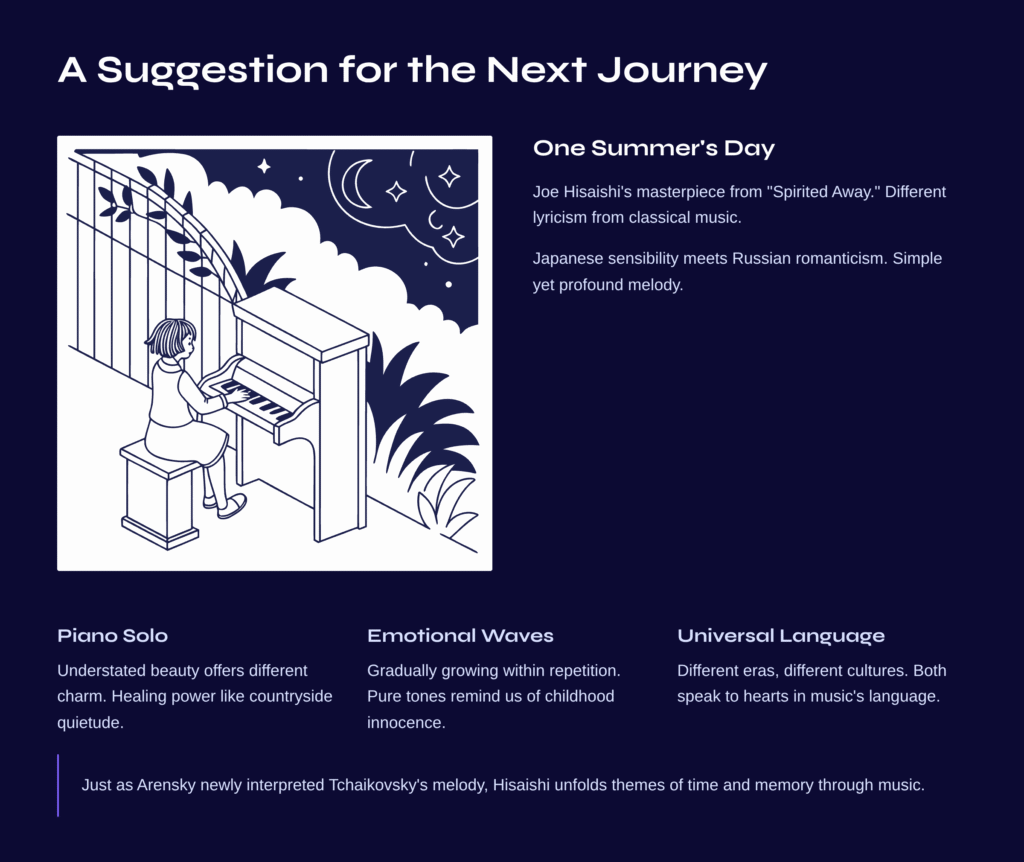
A Suggestion for the Next Journey
If the emotion gifted by Arensky’s variations still lingers in your heart, how about a journey to a slightly different world? Joe Hisaishi’s “One Summer’s Day” is a piece with a different kind of lyricism from classical music.
This representative piece from the Studio Ghibli animation “Spirited Away” contains Japanese sensibility completely different from the Russian lyricism shown in Arensky’s variations. A simple yet profound melody, emotional waves that gradually grow within repetition, and pure tones that remind us of childhood innocence.
Hisaishi shows how rich emotions can be expressed with just the piano alone. While the orchestral version is also beautiful, the understated beauty of the piano solo version offers a different charm from Arensky’s variations. The simplicity of this piece heard after the brilliance of the variations has healing power like the quietude of countryside encountered after complex city life.
Though born in different eras and different cultural spheres, both works speak to our hearts in music’s universal language. Just as Arensky newly interpreted Tchaikovsky’s melody, Hisaishi also unfolds the themes of time and memory through music in his own way.

